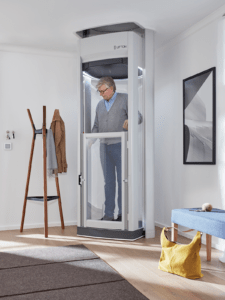 Home lifts or elevators are a popular solution for homeowners looking to stay in the home they love for longer when the stairs become challenging – often at an older age.
Home lifts or elevators are a popular solution for homeowners looking to stay in the home they love for longer when the stairs become challenging – often at an older age.
These types of assistive products have revolutionised the way people live in their homes and have come a long way since first entering the market in the 1990s. Modern domestic lifts are designed specifically for the home and gone are the slightly clunky, square-shaped, elevators that would look more comfortable in a medical setting.
Now home lifts look stylish and avant-garde and smoothly move between the floors of the home with minimal noise and fuss. The most likely place for a lift to be installed in the home is, naturally, in the inside of a property and, commonly will travel from hallway to main bedroom or upstairs landing area. Although these days, domestic lifts are so technologically advanced they can almost be fitted in any place in the home.
What is an exterior home lift?
However, occasionally, at Home Lift Experts, there might be a time where a homeowners may ask can you install an elevator on the outside of my house? The simple answer is, in theory, yes.
An exterior home lift can be described as typically where the elevator shaft is installed on the outside wall of a house. The user will enter and exit the lift from inside the property, although it could even be possible to access the lift from outside and into the home. If it is a hydraulic home lift, it may require a separate machine room to power it – this may have to be installed either inside or outside the house.
The advantages of installing a domestic lift outside the home is the homeowner will not need to sacrifice or ‘give up’ any space inside the property to accommodate the lift. It also may mean that no redirection of plumbing or electrical wiring is required too.
However, it depends on the property, as installing an exterior domestic lift may require a more bespoke solution and could involve complicated building work – and it may not look as ascetically pleasing outside. Some customers have added a bespoke home lift, for example, to an extension area that resembles a conservatory whereby it was a case of slotting the lift onto a landing area which accessed the main rear living room. In short, anything is possible, with installing a through floor lift these days, it is worth speaking to a specialist and having a site survey completed.
What is a Dummy Elevator?
A dummy lift or dummy elevator, also known as a dumbwaiter or freight lift – is a mini elevator that carries items from one floor to another. Dummy elevators are not big enough for a person to stand in and are usually found in restaurants, hotels or even hospitals. The typical size of a dumbwaiter is 20 inches deep by 20 inches wide and around 30 inches high but can vary depending on the use.
Some homeowners add a residential dumbwaiter to their home to help transport groceries, luggage, the vacuum cleaner, awkward boxes or even pets between floors. Dummy lifts are not, however, to be confused with home lifts or home elevators which carry actual people between floors.
How Small Can a Home Elevator Be?
The Lifton Home Lift is one of the smallest domestic lifts on the market and covers less than a square metre, taking up just 0.55m² surface area, which is also less than seven square feet.

Can You Add an Elevator to An Existing House?
Yes, it is entirely possible to add a home lift or home elevator to an existing house – it does not have to be a new-build UK house. The factors that need to be considered before retrofitting a lift to your home include:
Use: Before investing in a domestic lift, homeowners need to consider how long they plan to stay in the property and, as is mostly the case, whether they have an immediate need for it in the home due to a mobility or disability issue. Alternatively, they may be planning to future-proof their home with a lift for use in later life.
Location: Homeowners, with the help of a lift specialist, need to carefully consider the best place location in the home for the through floor lift and how much floor space will it take up in the property. If it is an older house, more structural work may be needed to ensure the lift can be safely installed. Certain properties may also require planning permission to have a home lift installed.
Budget: Depending on what is involved in the installation, adding a home lift to a property can be a costly – if there is a lot of building work required – so budgets need to be calculated to ensure it is feasible.
What is the Alternative to Elevators in Homes?
Platform lifts are considered an alternative to a home lift or home elevator and may be a more favourable and affordable option to older people, wheelchair users or other individuals with mobility or disability issues.
A platform lift tends to have four sides but is open on top and can typically carry two persons or one person in a wheelchair. It can be used inside the home to help, often wheelchair users, move between the floors of their home but is also used to raise a wheelchair and the occupant above a step or vertical barrier in an outside setting.
This type of solution is completely different to a domestic lift with many advantages and disadvantages and it needs to be carefully considered which solution is best for the user.

Recent Comments